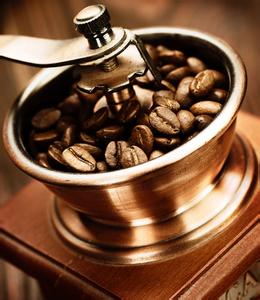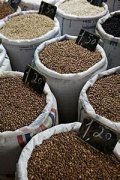A brief introduction to the flavor, taste and aroma characteristics of aromatic Ethiopian boutique coffee beans

It has been estimated that there are at least 2000 varieties of Ethiopian coffee and even more than 4500 kinds of coffee. Compared with the fat posture of Bourbon 'SL28', the main variety to the south of Kenya, or Tibica in Central and South America and Asia, Ethiopian beans look a little malnourished. But "beans" can not be seen, Ethiopian coffee has the most citrus aroma in the world, whether it is instant coffee or freshly ground coffee, you can smell the aroma of orange or lemon when you extract it. The nose is characterized by strong floral, fruity, sour and sweet aromas, but the alcohol is slightly thicker or less dense. The biggest disadvantage is that it is easy to bake unevenly, especially sun-dried beans. Even the best Grade3 Harald sun-dried beans often show uneven color, which is the biggest defect of Ethiopian beans, but the good thing is that it does not affect its good flavor. For coffee fans, you don't have to worry about what the beans look like, it's the most important thing. The stability of Ethiopian water-washed beans is much better than that of sun-dried beans, whose flavor fluctuates greatly every year, so be sure to test it several times before buying in large quantities. If you buy good sun-dried beans, their flavor is much deeper than water-washed beans, but if you buy improperly handled sun-dried beans, it will certainly make people speechless, which is the wish of many coffee fans.
Ethiopian beans are easily recognizable. Most of the beans are small and pointed long beans, the so-called 'longberry', and often mixed with small oval-shaped short beans, the so-called' shortberry', looks uneven in size and uneven in appearance. The commercial bulk beans of Grade4 or Grade5 are mostly mixed with hundreds of different seeds in different regions, so the uneven appearance of beans is the most obvious, and it is not easy to bake even Ethiopian coffee beans into five grades. The first and second stages are washed beans. Washed beans Grade1 represents 3 defective beans per 300g raw beans, and Grade2 represents 4 defective beans per 300g. Gradc1 grade water washed beans are very rare and are generally difficult to buy. At present, all the washed beans exported from Ethiopia are Grade2 grade. The quality of sun-dried beans is in the order of Grade3, Grade4 or Grade5. Although the defective beans in Grade4 are much less than those in Grade5, coffee farmers claim that in order to save tax on exports, they often lower the quality of Grade4 to Grade5 in order to save money. This may just be a marketing tactic, but in fact the quality of Grade5 is not as good as that of Gradc4.
Ethiopia has a unique flavor that is different from other flavors and provides customers all over the world with a wide range of taste choices.
In the highlands of southwestern Ethiopia, the Kaffa, Sheka, Gera, Limu and Yayu Senri coffee ecosystems are considered the hometown of Arabica coffee. These forest ecosystems also have a variety of medicinal plants, wild animals and endangered species.
The highlands of western Ethiopia have given birth to new varieties of coffee that are resistant to fruit disease or leaf rust. Ethiopia has many world-famous types of coffee. Some of the major types of coffee are famous for their unique aromas and flavors, including the following:
Limu Coffee
This kind of coffee grows in areas ranging from 1400 to 2000 meters above sea level. After wet processing, this kind of coffee has a rich fragrance, a full fruit with moderate acidity and alkalinity, high quality and attractive spicy flavor. It is estimated that out of 49000 hectares of cultivated area, the average annual production of this coffee is 29000 tons (equivalent to 480000 bags of 60 kg coffee).
Getachew Mengistie, director of Ethiopia's Bureau of intellectual property, bluntly pointed out that farmers sell raw beans for $1.45 a pound, while Starbucks sells for $26 a pound in the United States, 18 times the price difference between the two places. The reason is that Ethiopia does not know how to use intellectual property rights to create value for farmers. As long as it has the name of Ethiopian boutique beans, it can be marketed in the United States at three times the price of ordinary commercial beans. You know, investing in baking, packaging and marketing equipment through downstream channels in the United States alone cannot create such a huge added value, because most of the value comes from the coffee producing area (if Starbucks is not branded as "Sidamo", you can't sell it at such a high price. He stressed: "Ethiopia is the birthplace of coffee, and the famous producing areas of course have huge marketing value, but they are ignored by farmers. As a result, excess profits are finally earned by countries that know how to use the prestige of the place of origin to create value. It took no effort to earn it!
Ethiopia finally woke up and decided to learn from the skills of Western developed countries in mastering brands and creating value for the benefit of hard-working farmers, so in March 2005, Ethiopia applied to the United States Patent and Trademark Administration for the trademark rights of three famous places of origin, namely, Sidamo, Yega Xuefei and Harald. In the future, when American manufacturers sell high-quality coffee in these three places, they must be authorized by Ethiopia before they can put up the name of origin, so that hard-working farmers can get a more reasonable reward.
Oxfam estimates that once Ethiopia acquires the trademark rights of these three places of origin, it will increase Ethiopia's revenue by US $88 million a year. However, Starbucks challenged the US Trademark Office because Starbucks first applied for Sidamo as a trademark as early as two ○○ four years ago, and although the case is still under review, the first applicant has the upper hand. The Ethiopian ambassador to the United States negotiated with Starbucks and received a response: "Please talk to our lawyer directly." However, in ○○ six years, the United States Trademark Office approved Ethiopia to own the trademark "Yega Xuefei", while the names of the two producing areas, Sidamo and Harald, are still under consideration. Starbucks hired a large team of lawyers to step up defense firepower in an attempt to prevent Ethiopia from taking control of trademarks in two other producing areas.
The grade of sun-dried beans has never been regarded as a reference for the quality of a bean, but it is true that sun-dried beans are not as clean as water-washed beans, but they have a special sunny smell and the warmth of the sun.
This bean is a friend suggested that I must enter, he said that this batch, can not be missed. When the raw beans arrived, he also ordered them for the first time to show his support. Drink to the mouth, exclaimed: the original single Gemma is also so charming! Even full of gratitude to him, is really a good bean. The raw beans are basically neat in the sun beans from the outside, and the baking is a little similar to Harald, the entrance is very "African", wild, a little spicy, slightly bitter, but the texture is quite warm. The fruit in the latter section is delicate and strong, with a comfortable sense of natural cane sugar.
Even the official research unit of Ethiopia does not know how many Arabica subspecies there are in Ethiopia. The coffee cooperatives in this mountain are certainly different from those planted in another mountain, and even small farmers in the same region grow different varieties of coffee.
Important Notice :
前街咖啡 FrontStreet Coffee has moved to new addredd:
FrontStreet Coffee Address: 315,Donghua East Road,GuangZhou
Tel:020 38364473
- Prev

A brief introduction to the treatment method of grinding degree and baking degree of elegant and refined Rosa coffee beans
Rose coffee raw beans have a very beautiful turquoise, jade-like warm texture, smell of fresh grass, peach, berry and oolong tea that most coffee beans do not have, tropical fruit, strong sweetness; these are the feelings that Rose Summer has always given us. Properly baked, they make us feel like we're sipping a bunch.
- Next

The origin and development of Ethiopian fine coffee beans
Ethiopian coffee beans
Related
- Detailed explanation of Jadeite planting Land in Panamanian Jadeite Manor introduction to the grading system of Jadeite competitive bidding, Red bid, Green bid and Rose Summer
- Story of Coffee planting in Brenka region of Costa Rica Stonehenge Manor anaerobic heavy honey treatment of flavor mouth
- What's on the barrel of Blue Mountain Coffee beans?
- Can American coffee also pull flowers? How to use hot American style to pull out a good-looking pattern?
- Can you make a cold extract with coffee beans? What is the right proportion for cold-extracted coffee formula?
- Indonesian PWN Gold Mandrine Coffee Origin Features Flavor How to Chong? Mandolin coffee is American.
- A brief introduction to the flavor characteristics of Brazilian yellow bourbon coffee beans
- What is the effect of different water quality on the flavor of cold-extracted coffee? What kind of water is best for brewing coffee?
- Why do you think of Rose Summer whenever you mention Panamanian coffee?
- Introduction to the characteristics of authentic blue mountain coffee bean producing areas? What is the CIB Coffee Authority in Jamaica?

